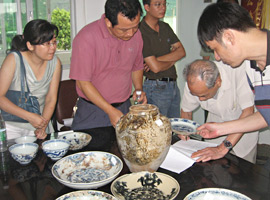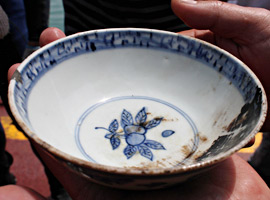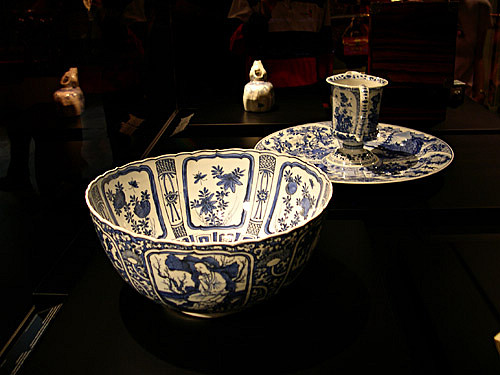|
 |
 |
|
CAREFUL OBSERVATION: Experts examine relics found in Nan'ao 1 (CFP) |
PRECIOUS FIND: A porcelain bowl salvaged from Nan'ao 1 (CFP) |
Sea road
As China's sea trade flourished gradually from the time of the Tang and Song dynasties (618-1279), a maritime Silk Road, also known as the "Porcelain Road," emerged, alongside the overland Silk Road.
Located at the intersection of the sea areas of Fujian, Guangdong and Taiwan, Nan'ao Island was a hub for marine traffic at that time, reaching northward to Japan and Korea, eastward to the Philippines, and southward to Java and Indonesia. It thus became an important transfer station on the sea route. Records show during Zheng's seven voyages to the "Western Seas" from 1406 to 1433, his fleet passed Nan'ao Island five times. The discovery of Nan'ao 1 also shows the island's geographical suitability as a center of maritime commerce.
The overland and maritime Silk Roads did not exert a significant influence on global trade when they first appeared, said Li, as commodities transported on the routes were mostly luxury items such as high-grade silk and porcelain ware for the use of royal families and nobility.
But, by the late Ming Dynasty, the imperial kiln of Jingdezhen alone could not meet the increasing demand for export. On the other hand, luxury goods were no longer the major portion of foreign trade. Instead, greater quantities of household utensils were being produced for export by private kilns, such as those in Pinghe of Fujian, showing overseas commerce had become an important component of China's coastal economy.
 |
|
EXQUISITE WORKS: A set of porcelain ute sils from China's Ming Dynasty (1368-1644) is shown in the Dutch National Museum in Amsterdam (CFP) |
Major Events in China's Underwater Archaeology
- In November 1987, the Underwater Archaeological Research Office of the National Museum of Chinese History, one of the two major components of today's National Museum of China, was set up, the first of its kind in China.
- In 1990, Chinese underwater archaeologists, together with foreign colleagues, carried out underwater explorations and excavations in the area near southeast China's Fujian Province, the country's first underwater operation of this type.
- In 1991-1997, Chinese archaeologists completed five explorations for and excavations of sunken ancient ships of the Ming Dynasty (1368-1644) in the water area near northeast China's Liaoning Province. This was the first underwater archaeological work done by China alone. The report on these archaeological activities was published in 2001, China's first formal underwater archaeological report.
- In 2007, Nanhai 1, an ancient sunken ship of the Song Dynasty (960-1279) found in the South China Sea, was salvaged completely, showcasing the preeminent place China's underwater salvage protection ideas and technologies occupy in the world.
- In May 2009, the Baiheliang Underwater Museum was opened in southwest China's Chongqing Municipality, showing China has attached increasing importance to the protection of underwater cultural relic sites.
- In 2010, the salvage of Nan'ao 1 was carried out, which will provide more information and materials to Chinese archaeologists concerning ancient ships.
(Source: People's Daily) | 